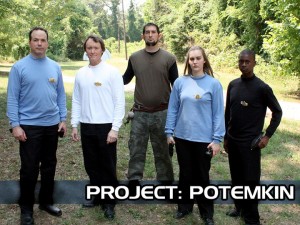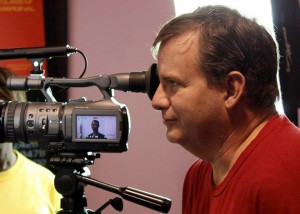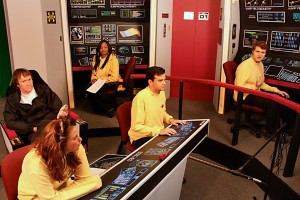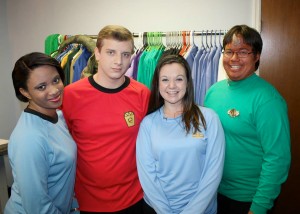 Without a doubt, we live in a veritable renaissance of Star Trek fan films… one after the other they come, dazzling us with intricate and expansive sets, elaborate green screen backgrounds, meticulously crafted costumes, breathtaking special effects, professional level make-up and lighting, and rich music and sound effects. Production teams in the hundreds often include veteran Star Trek actors and professional screenwriters who have worked in Hollywood. Heck, some of these fan films are even being shot in Los Angeles with crowd-sourced budgets well into the hundreds of thousands of dollars.
Without a doubt, we live in a veritable renaissance of Star Trek fan films… one after the other they come, dazzling us with intricate and expansive sets, elaborate green screen backgrounds, meticulously crafted costumes, breathtaking special effects, professional level make-up and lighting, and rich music and sound effects. Production teams in the hundreds often include veteran Star Trek actors and professional screenwriters who have worked in Hollywood. Heck, some of these fan films are even being shot in Los Angeles with crowd-sourced budgets well into the hundreds of thousands of dollars.
But what if your budget is missing four or five zeros at the end? What if you’ve got virtually nothing to spend on your fan film? With all the blazing supernovae of independent Star Trek cinematic achievements out there, is it even worth it to make just a simple “fan film” anymore?
Apparently, the answer is wholeheartedly yes, and Project: Potemkin has more than two dozen episodes online to prove it!
Project: Potemkin is a super low-budget, TOS movie-era fan film series based out of Albany, GA, a small city of 78,000 people in the southwestern part of the state, about 3 hours south of Atlanta. Kicking off in 2011, they’ve released 28 episodes so far, with a new episode being posted about once a month. Unlike many fan film series, however, Potemkin doesn’t bulk up their episodes into half-hour or hour-long presentations. Although one of their episodes, “The Night the Stars Fell From the Sky,” runs 54 minutes, the vast majority of Potemkin‘s offerings range between just 4 and 9 minutes long. So you can sample more than a half dozen of their episodes and not even invest a full hour doing so.

The driving force behind Project: Potemkin is Randall Landers, a down-to-earth, innovative, do-it-yourself Star Trek fan who, in his own words, “just wants to tell good stories.” I recently sat down for what I thought would be a brief interview to get some background for my next Fan Film Factor entry. But our conversation lasted much longer than the 30 minutes I’d anticipated. The interview I came away with was so interesting and fun that I’ve decided include it in its entirety, broken into two parts…
JONATHAN LANE: So, Randy, I read online that you got your start in fanzines.
RANDY LANDERS: Yes, that is absolutely correct. In June of 1979, we published “Stardate #1.” Within two years, we were publishing an issue every two months. They were only 40-90 pages, usually with one big story, one mid-size ending story, and one short story in the middle. In 1984, we had had to change our name to “Orion Press” because FASA began using “Stardate” for their own publication (and they were a licensee). We also published other fanzines like “Eridani” and “Number One”… and by 2009, we’d probably published a few hundred fanzine issues and distributed hundreds of thousands of copies.
JONATHAN: So why did you transition from fanzines to fan films?
RANDY: If you took your entire readership of a fanzine, it’s nothing compared to the number of people who are viewing an episode online. I never sold 30,000 copies of any of our fanzines – we’d be lucky to sell 3,000 – and yet “The Night the Stars Fell From the Sky” (one of our episodes) has had over 30,000 viewers just on YouTube. It’s been shown at a dozen conventions. More people have seen our videos than ever picked up our fanzines.
Look, I like telling stories, and my stories in particular are always short and to the point. One day back in 2009, I’m reading an article about a fan film called Paragon’s Paragon, and then I saw an episode of Starship Farragut, and I thought, “I can do this!”
Of course, I realized that I can’t do it as well as they can because they’ve got a budget. I don’t have that kinda budget. Even though I owned my own business in Albany, Georgia, I didn’t have that kind of money to invest in something that had no return… my wife would shoot me!

So in early 2010, I built the helm and navigation console myself. I ordered a carport from a place similar to Tassie Sheds Devonport and got to work. I measured up my double-wide carport, and finished constructing our first bridge set with the help of two of my friends, Ricky Thompson and Van Buchanan (we were all Little League coaches). It took us about four months, and I might have spent $1,500 total on that first bridge. We said, “Okay, we’re gonna do with a 22 and a half foot wide bridge.” It doesn’t look as big as Farragut’s bridge or Exeter’s bridge, but it looked pretty good, and we were pleased. We shot almost all of the first season in that carport, along with a few other locations, including a swamp! Swamps are wonderful.
JONATHAN: So it’s now 2010, you’ve got a homemade bridge set in your carport, you’re parking your cars on the street, and you want to film your first episode…
RANDY: I wanted to film a whole series!
JONATHAN: Fair enough. But you’ve got no budget. So where did you find actors? Did you ask your friends, or are there many Trek fans in Albany, Georgia?
RANDY: Neither, actually. We have two colleges nearby with Theater Arts departments. The first, Darton College, is a two-year community college, and that feeds into Georgia Southwestern University, and they actually offer a full degree in Drama. In fact, some of their graduates go on to the Savannah College of Art and Design, which is famous. We’ve actually had a couple of our actors go on to appear later in movies and TV shows. One is a regular background zombie on “The Walking Dead.”
JONATHAN: So did you just put up flyers in the student unions saying, “Actors wanted”?
RANDY: Nope. I went directly to Deborah Liss-Green, the drama professor at Darton, and I told her what I was doing. She said, “Great!” and promised to hook me up with her students. She also said that she’d send over her husband, Jeffrey Green, who is the Professor and Chair of Theater, Communication, and Media Arts at Georgia Southwestern State University, to meet with me.
JONATHAN: Wait a second. Isn’t Jeffrey Green the actor who plays Captain Grigory on your series?

RANDY: Yes, sir! Jeffrey is a professional actor; he’s part of the Screen Actors Guild (SAG-AFTRA). The second I saw him, I knew he was my captain. Actors, professional actors like Jeff, they have a bearing about them. I don’t know if it’s because they’re acting when they come in for an interview or just that’s what they do. But he came in and I said, “You’re joining our cast.” And he said, “Well, let me read for you.” And I’m like, “Okay.” He read for me, and I’m like, “You’re cast.” I mean, he’s wonderful.
JONATHAN: Well, at least that gave you one person in the crew who doesn’t look like he just got out of Starfleet Academy… or is still in it!
RANDY: It isn’t unusual to have crewmembers around college age serving active duty, especially ensigns and lieutenants. But I also contacted Mark Costello of Theatre Albany and said, “I need some of your actors,” because his actors are older than the college students. So Mark sent over some people, too.
JONATHAN: Now, I’m guessing you weren’t paying these actors anything…
RANDY: Just feeding and watering them.
JONATHAN: So were they Star Trek fans then?
RANDY: Nope, most of them weren’t… at least not when they first signed up.
JONATHAN: So then, to use an acting term, what was their motivation? Why work on a low-budget Star Trek fan film and do it all for free?
RANDY: Experience. There is nothing like having actual production experience. For example, during our first episode, “The Old Guys,” Jeff was there behind the scenes as the director of photography, but one of his grad students was the director. So Jeff’s teaching him how to direct. The students in particular were hungry for roles, and Theatre Albany doesn’t pay their cast either. So they’re just hungry for the exposure. And in one video, just one video, they’ve all had over a thousand views. So anyone who has been in any of our episodes has been seen by more people than ever have seen them in Albany, Georgia. It’s not true for Jeff, of course, because he’s been in films and TV, but for everyone else, it’s a great opportunity that they love to have.
JONATHAN: Now, another place I see where you’ve probably saved yourself some major bucks is costumes. Project: Potemkin takes place in the TOS movie-era…
RANDY: A few years after The Undiscovered Country.
JONATHAN: Yes, and in that time period, Starfleet officers are still wearing those elaborate “monster maroon” uniforms, which are pretty expensive to make (and probably really hot during a Georgia summer!). But instead of having full monster maroons, your actors just wear tunic shirts.
RANDY: Those tunics are still part of the uniform of the time. Our crew just doesn’t wear their maroon jackets over their shirts. But yes, I did manage to save a LOT of money with those outfits. Our actors have to buy their own black pants, black socks, and black shoes, but I supply the shirts.

In the first season, I went to a friend of mine who sells shirts to medical offices, and I said, “Kendra, I need some shirts.” And she says, “I have some.” I said, “I need these colors.” And she went and picked out samples. And I looked at the samples and said, “These’ll work just fine. How much are they?” Half of them were a dollar fifty apiece and the others were three dollars apiece. I bought 200 shirts! And you know what’s funny? I still have 50 shirts left! But we went through them… because the kids lose them. Actors leave us. We’ve had 55 actors as of the end of the second season; I haven’t even started counting the third season cast members. So we gave away a lot of shirts. If you were in our episodes, you get to keep the shirt. I hate to say this, but what’s three dollars? I spent more money feeding them and watering them then we did on the uniforms.
JONATHAN: Hold on a second! If you’ve only got 50 shirts left and you’re still on your third season, aren’t you going to run out of shirts???
RANDY: Not really. We’ve actually completed filming on 37 of the 40 episodes we’ll be making. Of those, 28 are online right now, and the rest will be coming out about once a month for the next year and a half or so.
JONATHAN: Ah, so that explains why you have listings on your website for all your third and fourth season episodes, even though they haven’t all been posted yet. So let me ask you about your scripts, because 40 is a lot. And they run the gamut: some are funny, some are serious, some are tragic and sad, some are action-adventure, some are ominous and creepy… when I start watching an episode of Potemkin, I never know what I’m going to get!
RANDY: Yeah, we like it that way!
JONATHAN: So for somebody who’s visiting the Fan Film Factor website who has never heard of Project: Potemkin before and goes to your website, which episode should they watch first so that they’ll want to watch more?
RANDY: Ah, damn… that’s a good question!
JONATHAN: And try not to say “The Night the Stars Fell from the Sky” because that one’s an hour of their time to be invested. You wanna give them the short ones to start with.
RANDY: Can I give them four, since they are short?
JONATHAN: You can give them four…yes.
RANDY: “Third Watch.”
JONATHAN: “Third Watch” is excellent.
RANDY: “Ashes.”
JONATHAN: Yes.
RANDY: I really like “Command Decision” right now.
JONATHAN: I was hoping you would say that one. That was the one that got me hooked on you guys.
RANDY: And for God’s sake, do not miss “Holding Pattern.” And I know the sound is wonky. If you only knew what we went through to get that episode out, you would applaud. But they need to see that one.
JONATHAN: Which of your episodes, if any, make you cringe?
RANDY: I cringe every time I watch “Care for a Lift?”
JONATHAN: Because you’re in it?
RANDY: Partially. I would love not to have shown that, but when you’ve got people who are putting work into an episode, hard work, you owe it to them to show it. They’re unpaid; they need to see it. And there’s been others, and I’m not gonna name ‘em, that I’m like, “Golly, that didn’t come out as well as I’d hoped.” But I owe it to that cast and that behind-the-scenes crew to put it out there. I’m not gonna tell you which one it is, but there’s one that I cringe at that everyone thinks is terrific.
JONATHAN: “Closing Time”?
RANDY: Yes.
JONATHAN How did I know? I cringed at that one, too. So, would you go back and do things differently on some of the weaker episodes if you could?
RANDY: Yes… and no. If I knew then what I know now, things would have been done differently. But I’m not gonna go spend my time and money redoing something we’ve already done.
 Check out Project: Potemkin episodes online here, and come back in a few days for PART TWO of this great interview… where we’ll find out where Potemkin gets its story ideas, what happens when actors don’t show up when they say they will, why Randy doesn’t do crowd-funding campaigns, and why each episode ends with a spoonful of borscht!
Check out Project: Potemkin episodes online here, and come back in a few days for PART TWO of this great interview… where we’ll find out where Potemkin gets its story ideas, what happens when actors don’t show up when they say they will, why Randy doesn’t do crowd-funding campaigns, and why each episode ends with a spoonful of borscht!
Ratings vary by episode from:
